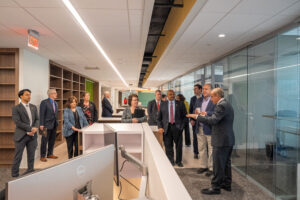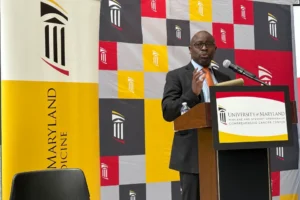Finance Committee pushes Cole Field House proposal forward, Maryland leaders react
It housed the game in which an all-black starting five won an NCAA men’s basketball championship for the first time. Elvis Presley once performed there. The Terrapins hoops programs called it home for more than 45 years.
Now, thanks in large part to a $25 million gift from university alumnus and Under Armour CEO Kevin Plank, Cole Field House might contain an indoor football practice facility, along with other programs.
The renovations rest on approval from the Board of Regents on Dec. 12, but Thursday afternoon, the University System of Maryland Finance Committee green-lighted the plans to repurpose Cole into a $155 million facility that includes the practice field as well as a center for entrepreneurship and a health research clinic open to the public.
“This is a transformative project because it brings together academics, research and athletics in ways that’s never been done before, at least not on this campus,” university President Wallace Loh said.
The university is branding the facility as a three-part project, one that incorporates the entire campus. The proposal states the university would begin planning the facility in May 2015, begin construction in December 2015 and finish the first phase by April 2017.
At the public Finance Committee hearing Thursday, members spoke for about 90 minutes and touched on several concerns ranging from funding to the relocation of student clubs to future relevance of college football given prevalence of concussions. But in the end, each member voted to push the proposal forward.
‘A GAME-CHANGER’
Since this university announced its decision to join the Big Ten in November 2012, Terps football coach Randy Edsall has been steadfast in his desire for an indoor practice facility, citing one as a draw for top athletes.
Nearly all of the Terps’ new conference opponents have indoor practice fields, and if the proposed renovations to Cole pass through the Board of Regents, Edsall said his program will thrive in the league.
“This is a game-changer for us,” Edsall said. “It shows the commitment for excellence. It shows a commitment to the students and student-athletes here at the University of Maryland.”
Added Tom McMillen, a Board of Regents member: “We are in the football business. We need to make this work and be competitive.”
The plans aim to preserve Cole’s history by creating the new facility within the existing structure. The iconic four white columns and red bricks on the south-facing entrance of the arena will remain, as will the name Cole Field House.
“There’s a lot of history there,” junior communications major Kyle Aceto, said. “I think the fact that this new facility will be in such a historic place will make athletes practice and try harder to get to that elite level.”
Inside the facility, most of the 14,000 seats would be removed to make room for one full-length turf field. Just outside of Cole, two outdoor practice fields would stretch into Lot 1 and take over between 700 to 750 parking spots.
The building would house the training rooms, football offices and other resources currently located in the Gossett Team House. The nonrevenue sports teams occupying the Varsity Team House would move into Gossett.
This comes at the same time as several other construction projects, such as the proposed Academic Village through the Department of Resident Life, which will result in three new dorms and a dining hall in Lot 1, about a 5-minute walk from Cole.
That’s left students concerned with the extensive reconfiguration of the campus.
“We already have so much construction going on and it’s not a good environment to be in when there’s so much stuff being built all the time and all these detours on the road,” freshman mechanical engineering major Ryan Barretta said. “It’s good they’re doing this for future generations of students but it’s bad for people who have to deal with the construction and change now.”
INNOVATION AND ENTREPRENEURSHIP
The Academy of Innovation and Entrepreneurship, a program set up for students to gain hands-on experience in creating and marketing ideas, is also included in the proposed plans.
There are 7,000 to 8,000 undergraduates enrolled in classes relating to entrepreneurship, and Loh said he hopes this program will reach all university students. This program will encourage students to develop apparel ideas as well as marketing, fundraising, public relations and lessons on how to grow companies.
With Plank’s donation, assistant vice president of marketing and communications Brian Ullmann said this program could serve as a “feeder system” for Under Armour, with students from across the university participating in research.
“There is a part of the academy called the innovation shell,” Ullmann said. “That’s where Under Armour could be beneficial in saying, ‘Help us design the next shoe or the next glove or the next helmet.’”
Plank is especially interested in encouraging athletes to try their hands at innovation, officials said. The Under Armour CEO served as special teams captain while playing for the Terps football team and launched several startups during his academic career at this university
“Plank wants to tell top athletes: You come here, we have this great facility, and we will make you entrepreneurial athletes,” Loh said. “I want to expose all student-athletes and all students to prepare them for a career that involves innovation and entrepreneurship.”
SPORTS MEDICINE
The Center for Sports Medicine, Health and Human Performance, a partnership between this university and the University of Maryland, Baltimore, will also be housed in Cole if the plans are approved.
The center will treat all athletic injuries, as well as injuries nonathletes face. The center’s research would include studying and improving human performance, whether that involves increasing running speeds, improving strength or designing custom training programs for each person’s needs. It will also feature a clinical operation to test the client’s body fat and heart rate and design a custom fitness and nutrition program.
Students pursuing careers in the medical field will be able to take on roles in the care and testing of patients at the clinic, which would be open to the public.
The Board of Regents approved The MPowering the State alliance with the University of Maryland, Baltimore in 2012, which enabled this university and UMB to collaborate on projects and research like this.
Dr. Andrew Pollak, chairman of the orthopaedics department at the medical school, said the program needed to be expansive and inclusive to provide the resources needed to conduct cutting-edge research.
“We envisioned the development of world-class facilities and programs for sports medicine and care and athletic training,” Pollak said. “The real challenge to that is when you try to build a clinical program for athletes that is world-class, doing it on a small scale is difficult.”
The partnership will mark the first time the medical school provides care to students in College Park who aren’t varsity athletes.
Still, the program is geared toward helping athletes by providing enhanced medical personnel and equipment, all in Cole.
“It’s a way we can make our student-athletes bigger, stronger, faster and even more competitive than they are now,” Athletic Director Kevin Anderson said.
FUNDING
While Plank gifted his largest donation to this university for the project, the rest of the money will come from various other sources: $25 million in state funds, $25 million from Big Ten revenues, $90 million in private donations, including Plank’s, and $5 million from this university. The remaining amount will be earned through academic programs and leasing clinical space in the facility.
Prior to the plans’ announcement and approval, the university raised $45 million of the anticipated $90 million in donations. Anderson said his goal is to raise more than $90 million for the project.
“Fundraising is going quite well, and we haven’t even launched the campaign or brought public that we’re doing this,” Anderson said. “Everybody that we’ve approached and talked to, we have heard nothing but enthusiasm and excitement. It’s been pretty electric.”
The construction of the indoor practice facility and the relocation of current programs housed inside Cole will cost $44 million while the remaining $111 million will be used for the academy, the center for sports medicine, football operations and indoor fields, Ullmann said.
The promising fundraising has Anderson and Loh confident they will be able to complete the project without the athletic department slipping into further debt.
Seven teams were cut from the university’s sports athletic department in July 2012 to balance the department’s budget. The teams eliminated included men’s and women’s swimming and diving, men’s tennis, acrobatics and tumbling, water polo, men’s indoor track and field and men’s cross country.
Aceto played water polo in high school and said he would’ve loved to play on a team here. He said that, while it’s unfortunate the cut sports teams won’t be returning any sooner, he understands why the Cole renovations are important.
“You have to look at the big picture and what sports make money for the school and will help the school in the future,” Aceto said. “This will sell the school to recruits and raise the bar. It’s a good business move.”
After announcing the move to the Big Ten, Loh said the athletic department was on track to repay its debt by 2018, when it would begin running a profit. Anderson said repurposing Cole would not delay the process.
“We are very confident right now in this that we are going to stay on course,” Anderson said, “and achieve the goals we set out to.”
To Loh, the athletic department’s success would reverberate throughout the university community.
Cole Field House and the events it hosted once brought prominence to the campus, and now, officials are hoping a multifaceted facility in the building will do the same.
“Athletics are the front porch of the University House — thousands of people who view athletics on cable televisions see the front porch,” Loh said. “What we are doing now is to connect the front porch between the rest of the academic house.”
Senior staff writer Talia Richman contributed to this report.



